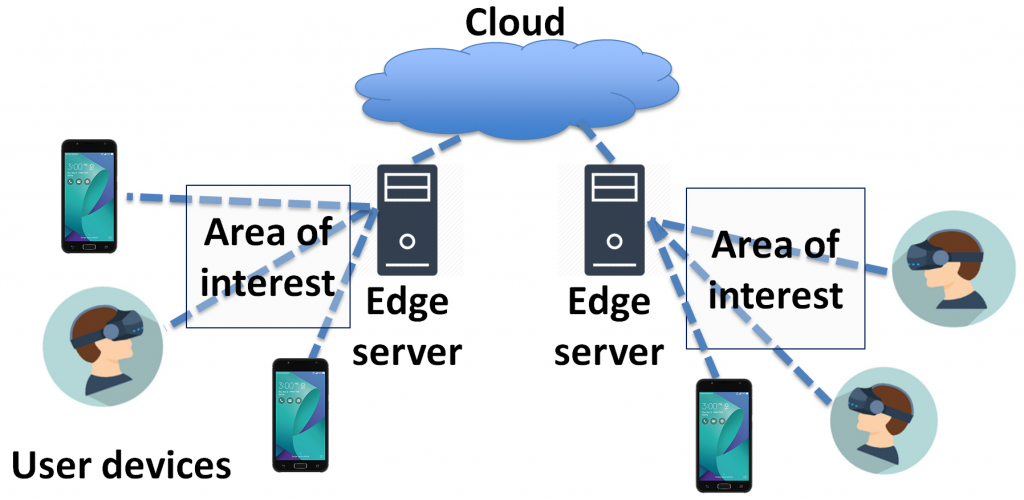Our work on using edge computing to transmit holograms to augmented reality (AR) users has recently appeared in the IEEE SmartEdge Workshop, co-located with IEEE PerCom, as an invited paper. [ Paper PDF ] [ Presentation slides ] [ Video of the presentation ]
 High-level architecture: edge computing supporting different users’ augmented reality (AR) experiences.
High-level architecture: edge computing supporting different users’ augmented reality (AR) experiences.
The motivation for this work is to enable contextual and personalized AR experiences: to display different holograms under different conditions and to different users. It would be limiting to attempt to pre-store, on a mobile device itself, all possible holograms that could be displayed under different conditions. Rather, we store the holograms on an edge server, transmitting them to mobile devices only when necessary. We explore two types of edge-based transmissions: on-demand transmissions, where holograms are transmitted when requested by the user, and proactive transmissions, where holograms are transmitted to the users ahead of when they are needed.
This work is led by two Duke University undergraduate students, Michael Glushakov and Yunfan Zhang. Michael developed a Google ARCore-based edge hologram provisioning framework (he previously presented elements of his work at a Duke CS undergraduate research poster showcase), and used the developed framework to investigate which file types we should be using when storing holograms on the edge. Michael’s code is available here. Yunfan developed an edge hologram provisioning framework for Magic Leap One AR devices; his code can be downloaded here. Taking a close look at the developed hologram provisioning frameworks, we additionally defined several challenges and research directions for larger-scale implementations of such edge-based architectures, including the need to provide holograms at different levels of detail, and the need to develop customized hologram transmission and caching policies for proactive hologram transmissions.
Related materials:
- Paper PDF: M. Glushakov, Y. Zhang, Y. Han, T. Scargill. G. Lan, M. Gorlatova, Edge-based Provisioning of Holographic Content for Contextual and Personalized Augmented Reality, in Proc. IEEE Workshop on Smart Edge Computing and Networking (co-located with IEEE PerCom), Austin, TX, Mar. 2020 (invited paper).
- Presentation slides – presented by M. Glushakov.
- Video of the presentation
- Google ARCore-based hologram provisioning framework: open-source code by M. Glushakov.
- Magic Leap One-based hologram provisioning framework: open-source code by Y. Zhang.
This work is supported in part by NSF grants CSR-1903136 and CNS-1908051 and by the Lord Foundation of North Carolina.
